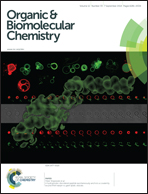Electrochemical and theoretical analysis of the reactivity of shikonin derivatives: dissociative electron transfer in esterified compounds†
Abstract
An electrochemical and theoretical analysis of a series of shikonin derivatives in aprotic media is presented. Results showed that the first electrochemical reduction signal is a reversible monoelectronic transfer, generating a stable semiquinone intermediate; the corresponding E0I values were correlated with calculated values of electroaccepting power (ω+) and adiabatic electron affinities (AAd), obtained with BH and HLYP/6-311++G(2d,2p) and considering the solvent effect, revealing the influence of intramolecular hydrogen bonding and the substituting group at position C-2 in the experimental reduction potential. For the second reduction step, esterified compounds isobutyryl and isovalerylshikonin presented a coupled chemical reaction following dianion formation. Analysis of the variation of the dimensionless cathodic peak potential values (ξp) as a function of the scan rate (v) functions and complementary experiments in benzonitrile suggested that this process follows a dissociative electron transfer, in which the rate of heterogeneous electron transfer is slow (∼0.2 cm s−1), and the rate constant of the chemical process is at least 105 larger.


 Please wait while we load your content...
Please wait while we load your content...